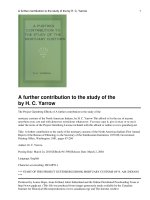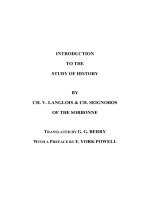Biology the study of life
Bạn đang xem bản rút gọn của tài liệu. Xem và tải ngay bản đầy đủ của tài liệu tại đây (2.06 MB, 44 trang )
EEES 2150- Biodiversity
Biology: Evolution, Diversity, and
Ecology
Biology:
The study of life.
Some Properties of Life
•
•
•
•
•
•
•
Order
Reproduction of Own Kind
Growth and Development (Differentiation)
Utilization of Energy
Response to Environmental Stimuli
Homeostasis (Internal Environment)
Evolutionary Adaptation
Some Properties of life: Order
Reproduction
Growth and Development
Energy Utilization
Ten Underlying Biological Themes
1. Biological organization and its structural hierarchy:
Atoms
↓
Molecules
↓
Organelles
↓
Cells
(Single and as subunits)
↓
Multi-cellular Organisms
(Specialization into tissues, organs, organ systems)
↓
Beyond Individual Cells
(Groups of organisms in same species = population; of different species
= communities; and when one adds the non-living, environmental
components = ecosystem)
***Each level in the biological hierarchy has its own novel properties;
these are called emergent properties.
The hierarchy of biological organization
Terrestrial Biomes
Marine Biomes
Climograph
2.The cell is the basic unit of life.
(Robert Hooke, 1665, first described cells; Antoine von
Leeuwenhoek studied pond water, etc.). In 1839, it was
proposed that all life was composed of single cells.
Two main types of cells – all contain DNA (molecule that
makes up chromosomes, which contain the genes that tell
cells how to differentiate).
- Prokaryotic (no organelles) = bacteria, Archae
- Eukaryotic (organelles) = all other forms of life
3. Continuity of life based on a heritable universal genetic
code in the form of DNA.
- DNA (Deoxyribonucleic acid) molecule contains
instructions for producing new organisms.
- Each DNA molecule consists of two long chains in a
double helix. Chains consist of four molecules called
nucleotides: adenine, guanine, cytosine, thymine.
- Replication (exact) of DNA allows for life’s continuity
and mistakes are the driving force for evolution (mutations).
- All the nucleotides are organized into genes.
-All genes together = genome.
4. Structure and function are correlated.
If you know one, you can intuit the other.
For example, a bird’s bones are mostly hollow…
Form fits function
5. Organisms interact with the environment.
They take in energy and resources from the
environment, and often convert these to
different more-useful formats.
They exchange energy and materials with the
environment.
These interactions mean organisms are open
systems.
6. Living Organisms Have Regulatory Systems.
E.g., If we take in food, its energy is given off via
controlled (regulated) chemical reactions to produce life
functions and some heat. If we burn the food, energy is
given off only as heat (unregulated chemical reactions).
- Controlled process is catalyzed by enzymes function
as regulatory mechanisms.
Negative feedback, Feedback inhibition
- Final product inhibits first enzyme, so no more product is
produced.
Positive feedback
- Product enhances the rate of an enzyme in the reaction
sequence.
7. Unity & Diversity are “hallmarks” and are linked.
Earth has approximately 1.5 million identified species
with estimates of 5-10 million once all are known. Two
questions emerge:
- How did we get all this diversity?
- Is there an underlying unity to life?
To answer these questions, organisms have been
placed into groups that form a framework to study diversity
via interrelationships between living organisms.
the current classification system:









